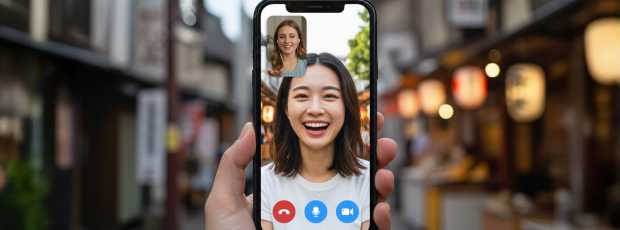Had a fantastic tour with Kenya back in January exploring many of Kyoto's beautiful sights. Very knowledgeable, friendly and especially helpful with taking photos and videos since I was a lone traveller!Nick, Kyoto, 2025
Table Of Contents
- The Poetry of Peak Fall Foliage
- Sacred Spaces Enhanced by Seasonal Beauty
- Festival Season: When Tradition Comes Alive
- Hidden Gems: Beyond the Famous Sites
- Practical Wisdom for October Visitors
- Culinary Autumn: Seasonal Flavors
- Photography and Memory Making
- Planning Your October Journey
- The Deeper Meaning of Autumn in Kyoto
- Conclusion: The Lasting Gift of October in Kyoto
In my family, we have always measured time not by calendars alone, but by the subtle shifts in light and leaf.
October marks what we call the "threshold season"; when summer's final warmth mingles with autumn's promising coolness.
The fall season brings with it a particular quality of light that photographers and painters have long sought to capture, though few succeed in conveying its true essence.

Morning mist rising from a traditional temple garden. Image by Johnny Ho from Unsplash
I've found that the city awakens differently in October. Temple bells seem to carry farther in the crisp air. The sound of wooden sandals on stone paths has a sharper clarity.
Even the way incense smoke rises from shrine altars appears more deliberate, more purposeful.
This transformation extends beyond the visual.
October in Kyoto engages all the senses in ways that other seasons cannot match.
The scent of fallen leaves mixes with the faint aroma of burning wood from temple braziers.
The texture of morning air against your skin tells stories of the changing season long before your eyes register the first hints of color change.
The Poetry of Peak Fall Foliage
When visitors ask me about the best time to witness our autumn leaves, I always pause before answering.
The truth is that fall foliage in Kyoto runs on nature's schedule, not ours.
With that said, October consistently offers what I consider the most rewarding experience for those who know how to look.

Close-up of Japanese maple leaves in various stages of autumn color change. Image by Chris from Unsplash
The maple trees that line our temple grounds begin their transformation in early October, starting with the highest branches.
From there, the color spreads downward like watercolors bleeding through rice paper.
By mid October, many of our most treasured viewing spots display a natural mosaic that changes hourly as light shifts throughout the day.
The fall colors intensify throughout the month. Early October offers subtle transitions, perfect for those who appreciate gradual change.
Late October provides the dramatic displays that attract photographers from around the world. Both experiences carry their own rewards for those willing to observe carefully.
See Kyoto in October, Your Way
Explore fall in Kyoto with a local who tailors the experience to you. No scripts, no groups, just your perfect day.

Kiyomizu-dera Temple's wooden stage with autumn valley view below. Image by Nelemson Guevarra from Unsplash
Sacred Spaces Enhanced by Seasonal Beauty
Kiyomizu-dera Temple: Where Autumn Meets Devotion
Kiyomizu-dera Temple has watched over our city for over twelve centuries, and October grants it a particular majesty.
The temple's famous wooden veranda, suspended above the valley, provides one of the most celebrated views of autumn foliage in all of Japan.
I recommend visiting Kiyomizu-dera Temple in the early morning hours, when the first light touches the maple leaves in the valley below.
The temple halls seem to float above a sea of color, creating what many describe as a breathtaking sight.
The wooden platform creaks softly underfoot, a reminder of the countless pilgrims who have stood in this same spot, seeking the same sense of wonder.
The path leading to Kiyomizu-dera Temple becomes particularly meaningful in October.
The narrow streets lined with traditional wooden buildings frame glimpses of colored leaves ahead, building anticipation with each step.
Street vendors begin offering seasonal sweets made with chestnuts and persimmons, adding another layer to the sensory experience.

Narrow cobblestone street leading uphill to Kiyomizu-dera Temple. Image by Kouji Tsuru from Unsplash
From Kiyomizu-dera Temple, you can follow walking paths that connect to other significant temples in the eastern district.
The stone pathways wind through neighborhoods where traditional architecture creates perfect frames for the changing leaves.
These connections remind us that in Kyoto, sacred spaces exist not as isolated destinations but as parts of a larger spiritual landscape.
The sub temples each offer different perspectives on the autumn display.
Some maintain carefully composed gardens where every maple tree has been positioned for optimal viewing.
Others preserve more natural areas where autumn happens according to its own pace.
Tofukuji Temple: The Master of Maple Viewing
Tofukuji Temple commands respect among those who truly understand autumn in Kyoto.
This Zen temple complex encompasses vast grounds where over two thousand maple trees create what many consider the finest fall display in our city.
Tofukuji Temple requires careful timing for the best experience.
See Kyoto With a Local by Your Side
Get matched with a local who plans your perfect Kyoto day. It's flexible, thoughtful, and shaped entirely around you.

Tofukuji Temple's famous bridge surrounded by autumn maple canopy. Image by Caleb Jack from Unsplash
The temple's most famous viewpoint, the Tsutenkyo Bridge, spans a valley dense with maple trees. In October, standing on this bridge feels like floating above clouds of red and gold.
he bridge itself becomes part of the autumn composition, its dark wood contrasting beautifully with the vibrant foliage below.
I think Tofukuji Temple requires careful timing for the best experience.
I suggest arriving at opening time to avoid the crowds that gather later in the day. The temple grounds are extensive, allowing visitors to find quieter spots even during peak viewing times.
The large complex includes multiple viewing areas, each offering different perspectives on the magnificent autumn colors.
Walking through Tofukuji Temple's grounds, you encounter not just visual beauty but also the sound of autumn.
Leaves rustle differently when they're dry and ready to fall.
The temple's meditation halls amplify these subtle sounds, creating an acoustic environment that enhances the visual experience.
The Philosopher's Path: A Meditation in Motion
The Philosopher's Path represents one of Kyoto's most beloved walking routes, connecting several temples while following a canal lined with hundreds of cherry trees.
While famous for cherry blossom season, October reveals a different character along this path.

Stone path along a canal with autumn trees reflecting in the water. Image by David Emrich from Unsplash
Along the Philosopher's Path, small temples and shrines appear at regular intervals. Each offers a different perspective on the season.
Some maintain traditional gardens where carefully placed maple trees create composed views.
Others preserve wild areas where autumn happens according to natural rhythms rather than human design.
The path connects major temples including the Silver Pavilion and several others in the northern Higashiyama district.
This connection allows visitors to experience temple-hopping while enjoying continuous autumn scenery.
The walking distance between major sites remains manageable, making this route particularly appealing for those who prefer to explore on foot.

Traditional tea house along the Philosopher's Path with outdoor seating. Image by Bubba from Unsplash
Street-side tea houses along the Philosopher's Path serve seasonal specialties in October, which are delicious and worth a trip in itself.
Warm amazake, a sweet rice drink, provides comfort on cooler days.
Traditional sweets made with persimmons and chestnuts reflect the season's flavors.
The path itself changes character throughout October.
Early in the month, the walkway provides gentle autumn hints mixed with lingering summer green. Late October transforms the same route into a corridor of gold and crimson that rivals any formal garden design.
Festival Season: When Tradition Comes Alive
October in Kyoto means festival season, when our most important traditional celebrations fill the streets with color, music, and ancient ritual.
These events offer visitors glimpses into cultural practices that have continued for over a thousand years.
Jidai Matsuri: A Parade Through Time
The Jidai Matsuri represents one of Kyoto's three greatest festivals, held annually on October 22nd.
This procession recreates historical periods from Japan's imperial past, with participants dressed in meticulously researched historical garb representing different eras.

Festival participants in elaborate historical costumes during Jidai Matsuri, Image by Tong Su from Unsplash
The festival begins at the Kyoto Imperial Palace and proceeds through the city center to Heian Shrine.
Over two thousand participants wear authentic reproductions of clothing from various periods in Japanese cultural history.
The procession takes several hours to complete, creating a living timeline of our nation's history.
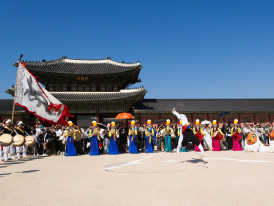
Grand entrance gates of Kyoto Imperial Palace with festival participants in colorful historical costumes gathering in the courtyard. Image by Shibin Joseph from Unsplash
The festival route passes several significant landmarks, allowing spectators to position themselves strategically for the best viewing experience, and representing Japanese cultural history.
The procession moves slowly, providing ample time to appreciate the details of each historical period represented.
Traditional music accompanies the parade, with different instrumental groups representing various eras of cultural history.
Jidai Matsuri attracts many visitors, but the procession route is long enough that finding good viewing spots remains possible.
Local families often stake out favorite locations early in the day, creating a community atmosphere that enhances the festival experience.
Kurama Fire Festival: Ancient Power in Modern Times
The Kurama Fire Festival, held on October 22nd in northern Kyoto, is one of Japan's most dramatic traditional celebrations.
This event dates back over a thousand years and centers on the community's relationship with fire as both destroyer and purifier.

Large torches being carried through mountain village streets at night.
The festival begins at dusk when residents of Kurama village light massive torches and carry them through narrow mountain streets.
The sight of these flames against the backdrop of autumn foliage creates an almost supernatural atmosphere. Chants of "Sai-rei, Sai-ryo" echo through the valley as the procession moves toward the local shrine.
Young men carry increasingly large torches as the evening progresses, culminating in enormous flames that require multiple people to manage.
The festival reaches its climax when a portable shrine is carried from the mountain shrine down to the village, accompanied by the largest torches of the evening.
The Kurama Fire Festival will require planning to attend. The village is small, and the number of spectators is limited by safety considerations.
Arriving early in the day allows visitors to explore the mountain area and understand the geographical context that makes this festival so powerful.
The combination of fire, mountain setting, and autumn season creates an experience that engages primal emotions often missing from modern festival celebrations.
The smell of wood smoke mixes with the scent of fallen leaves. The heat from the torches contrasts with the cool mountain air.
These sensory contrasts contribute to the festival's impact and make it a wonderful experience.
Sato Matsuri and Local Celebrations
Beyond the major festivals, October brings numerous smaller celebrations throughout Kyoto.
The Sato Matsuri and similar local events offer intimate glimpses into neighborhood traditions that tourists rarely encounter.
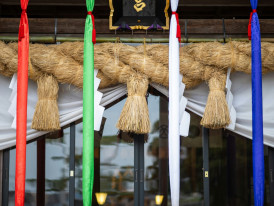
Local shrine festival with traditional decorations. Image by Kouji Tsuru from Unsplash
You'll find that these smaller festivals often center on neighborhood shrines where shrine deities receive offerings and prayers for the coming season.
Community members work together to prepare decorations, cook traditional foods, and organize performances that have been passed down through generations.
The Zuiki Matsuri at Kitano Tenmangu Shrine exemplifies these local celebrations.
Decorations made entirely from vegetables and grains create temporary art that celebrates the autumn harvest.
The festival combines religious observance with artistic expression, reflecting the deep integration of sacred and secular life in Kyoto.
Local festivals give tourists opportunities to interact with Kyoto residents in relaxed settings.
Community members often welcome respectful visitors and enjoy sharing stories about their neighborhood traditions.
These encounters offer insights into daily life that complement the grandeur of major temple visits.
Small shrine celebrations throughout the city demonstrate how festival traditions adapt to neighborhood needs while maintaining essential spiritual and cultural purposes.
These events show off the living nature of traditional culture in contemporary Kyoto.
Hidden Gems: Beyond the Famous Sites
While Kyoto's most popular temples deserve their reputation, October gives a peek at the beauty of lesser-known locations that offer equally rewarding experiences without the crowds.

Small temple garden with perfectly maintained autumn landscape. Image by David Emrich from Unsplash
Northern Districts: Where Autumn Feels More Intimate
Northern Kyoto contains numerous temples and gardens that provide spectacular autumn viewing with fewer visitors.
These areas require more effort to reach but reward that effort with more personal encounters with the season.
The Kamigamo Shrine area, for example, includes several smaller temples where maple leaves create intimate viewing spaces.
These locations allow visitors to experience autumn contemplation without the distractions of large crowds. The silence in these spaces becomes part of the aesthetic experience.
Many of these hidden gem locations remain unknown to casual visitors, preserved by their distance from major tourist routes.
However, those willing to venture beyond the famous sites often find that these quieter temples provide more profound experiences of autumn's spiritual dimensions.
Bamboo Grove Secrets
While the famous bamboo grove in Arashiyama draws many visitors, October reveals lesser-known bamboo areas where the interplay between evergreen bamboo and deciduous trees creates unique autumn compositions.

Bamboo grove with golden autumn light filtering through. Image by Shunya Koide from Unsplash
The contrast between bamboo's consistent green and the changing colors of surrounding trees highlights both permanence and change. I think these are fundamental concepts in Japanese aesthetics.
These stunning visual contrasts become more pronounced in October's changing light conditions.
During this month, the sound environment in bamboo groves changes.
The rustling of both bamboo leaves and fallen deciduous leaves creates complex audio textures.
Wind moves differently through bamboo versus other trees, creating subtle variations in natural sound that enhance the meditative quality of these spaces.
Some alternative bamboo locations often connect to temple grounds or traditional gardens, creating extended walking experiences that combine different types of natural beauty.
The transitions between bamboo areas and maple-focused gardens provide opportunities to appreciate the full range of autumn's visual offerings.
Practical Wisdom for October Visitors
Timing Your Temple Visits
Understanding when to visit different temples can dramatically improve your autumn experience in Kyoto. Each location has optimal viewing times that depend on both natural factors and visitor patterns.
Most temples open at 6:00 AM during autumn season, providing opportunities to experience these sacred spaces in relative solitude.
The quality of light in early morning enhances the colors of autumn leaves while creating peaceful atmospheres for contemplation.
I strongly encourage visitors to visit early whenever possible.
Late afternoon visits, particularly in the hour before sunset, offer different rewards. The warm light of approaching evening makes red maple leaves appear to glow from within.
However, these times also attract more visitors, requiring patience and strategic positioning for the best views.
Evening illuminations at selected temples can go beyond viewing opportunities into night hours. These artificial lighting displays create dramatic effects but offer experiences quite different from natural autumn viewing.
Night illuminations typically begin in early November and continue through late November, overlapping with peak autumn colors.

Traditional wooden temple notice board displaying multiple schedule announcements in Japanese and English
Temple schedules vary throughout October, with some locations extending hours during peak color periods.
I would recommend checking current information before your visit helps ensure you can experience optimal viewing conditions at your chosen destinations.
Make October in Kyoto Yours
See Kyoto in a way that reflects your interests, with a local host who plans a private experience around you.
Navigation and Transportation
Getting around Kyoto during autumn season calls for good planning, as popular destinations attract many visitors. Understanding transportation options helps maximize your time while minimizing stress.

Traditional train station platform with autumn mountain views in background. Image by Kouji Tsuru from Unsplash
Kyoto Station is the central hub for most transportation within the city. From here, the stations connect to major temple districts via various rail lines.
The JR Nara Line provides direct access to Tofukuji Temple and other southeastern destinations. Other lines serve different districts efficiently.
Bus transportation offers flexibility for reaching temples not directly served by rail lines.
However, autumn season brings increased ridership that can make bus travel slower and more crowded.
Combining walking with strategic use of public transportation often provides the best balance of efficiency and experience.
Google Maps proves invaluable for navigation, but understanding its limitations in Kyoto becomes important. Some temple grounds are large enough that the mapped location might not correspond to the optimal viewing areas.
Traditional paper maps available at information centers often provide better context for temple layouts and walking routes.
Many of Kyoto's best autumn experiences exist within walking distance of each other, particularly in the eastern temple districts.
Planning walking routes that connect multiple locations allows for serendipitous discoveries while providing exercise that enhances the overall experience.
Transportation planning should account for increased travel times during peak autumn periods.
Popular destinations experience heavier traffic, both vehicular and pedestrian.
Building extra time into your schedule prevents rushing and allows for spontaneous stops when you encounter unexpected beauty.
Seasonal Considerations and Comfort
October weather in Kyoto requires layered clothing as temperatures can vary significantly throughout the day. Morning visits to mountain temples might require warm clothing, while afternoon sun can make lighter clothes more comfortable.

Visitors dressed appropriately for autumn temple visiting. Image by Tantan Wiguna from Unsplash
Comfortable walking shoes are essential for temple visits, as many locations involve uneven stone paths and steps.
The combination of fallen leaves and stone surfaces can create slippery conditions, making stable footwear a safety consideration as well as a comfort issue. Be careful out there!
Carrying a small backpack with water, snacks, and a light jacket allows for extended exploration without fatigue.
Many temple areas have limited food options, making self-sufficiency advantageous for longer visits. Traditional neighborhoods near temples often include small shops selling seasonal treats that enhance the cultural experience.
Photography equipment considerations include extra batteries, as cool weather can drain power more quickly. The changing light conditions of autumn require flexibility in camera settings.
However, remember that some temples restrict photography in certain areas, making advance research worthwhile.
Weather preparation should include rain gear, as October occasionally brings sudden showers that can enhance rather than diminish the autumn experience.
Many visitors find that light rain intensifies autumn colors while creating a more intimate atmosphere at temple sites.
Culinary Autumn: Seasonal Flavors
October brings seasonal ingredients that appear in both temple cuisine and neighborhood restaurants throughout Kyoto. Understanding these seasonal flavors adds another dimension to your autumn experience.

Traditional Japanese sweets featuring autumn ingredients like persimmons and chestnuts.
Traditional Seasonal Ingredients
Persimmons ripen in October, appearing in both sweet and savory preparations throughout the city. These fruits, with their brilliant orange color, mirror the autumn foliage and provide natural seasonal markers in local cuisine.
Chestnuts are prominent in October cooking, appearing roasted as street food and incorporated into elegant sweets served at temple tea houses.
The nutty flavors complement the season's contemplative mood while providing warming nutrition for cooler days.
Mountain vegetables harvested in autumn appear in temple cuisine served at several locations throughout the city. These ingredients, prepared according to Buddhist principles, offer pure flavors that complement the spiritual aspects of temple visiting.
Local sake breweries begin releasing autumn varieties in October, often featuring seasonal ingredients or brewing techniques that reflect the changing season.
I find that these beverages pair well with the contemplative pace of autumn temple visiting, though consumption should be moderate and respectful.
Tea culture reaches particular significance in October, as the weather becomes ideal for appreciating both hot beverages and the meditative aspects of traditional tea preparation.
Many temples maintain tea houses where visitors can rest while contemplating garden views enhanced by autumn colors.
More than 26,274 5-star reviews and counting
26,274+ 5-Star Reviews and Counting
Trusted and recommended by travelers worldwide.
Temple Food Traditions
Traditional Japanese cuisine finds special expression in temple settings during autumn, where Buddhist principles of seasonal eating align perfectly with October's natural offerings.

Traditional temple meal featuring seasonal autumn ingredients.
Temple restaurants throughout Kyoto serve kaiseki-style meals that celebrate autumn ingredients through careful preparation and artistic presentation.
These meals provide cultural education alongside nourishment, demonstrating how seasonal awareness influences traditional Japanese aesthetics.
Vegetarian temple cuisine, known as shojin ryori, reaches particular heights during autumn when the variety of seasonal vegetables allows for complex and satisfying meal compositions.
These dishes demonstrate how restrictions can inspire rather than limit culinary creativity.
The presentation of temple meals reflects autumn aesthetics through choice of serving vessels, arrangement of ingredients, and incorporation of seasonal visual elements.
These meals become extensions of the temple visit experience, reinforcing themes of seasonal awareness and mindful consumption.
Photography and Memory Making
October in Kyoto presents extraordinary photographic opportunities, but capturing the true essence of autumn here requires understanding both technical and cultural considerations.
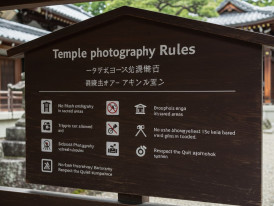
Sign in both Japanese and English explaining temple photography rules
Respectful Photography Practices
Understanding photography etiquette becomes essential when visiting sacred spaces during busy autumn season. Many temples have specific areas where photography is prohibited, while others welcome respectful image-making.
Temple halls and inner sanctuaries typically prohibit photography out of respect for ongoing religious practices.
However, garden areas and exterior architectural features generally welcome photographers who work quietly and respectfully.
Crowd management becomes important during peak autumn viewing times. Waiting for clear shots requires patience, but the results justify the extra time investment.
Early morning visits provide the best opportunities for unobstructed photography.
Sharing pathways considerately ensures that other visitors can also enjoy optimal viewing opportunities.
This courtesy becomes particularly important during peak color periods when popular locations attract large numbers of photographers and sightseers.
Professional photography equipment draws attention in temple settings, making discrete gear choices preferable for those seeking candid images of temple life and visitor interactions.
Simple camera setups often produce more natural results in these environments.
Planning Your October Journey
Creating an effective itinerary for experiencing autumn in Kyoto requires balancing must-see destinations with flexibility for spontaneous encounters. Understanding the things to do in Kyoto in October helps prioritize experiences while leaving room for serendipitous encounters.

Visitors walking through temple grounds with guide book, planning their route
Essential Experiences Not to Miss
Certain experiences define October in Kyoto and deserve priority in any visit planning.
These activities capture the essential character of autumn in our city while providing memories that will endure long after the trip ends.
Witnessing sunrise from a temple veranda provides one of the most profound autumn experiences available in Kyoto.
The combination of morning mist, changing leaves, and sacred architecture creates moments of genuine transcendence that justify early morning wake-up calls.
Participating in or observing a traditional festival adds cultural depth to the seasonal experience.
These events connect visitors to cultural traditions that have continued for over a thousand years, providing context for understanding Kyoto's role in preserving Japanese heritage.
Walking meditation along temple paths allows for personal reflection while experiencing the seasonal beauty that has inspired spiritual practice for centuries.
These walks require no special skills or knowledge, just openness to the experience of moving mindfully through beautiful spaces.
Sharing a traditional meal featuring seasonal ingredients creates another layer of cultural immersion.
Whether in a temple restaurant or neighborhood establishment, seasonal cuisine connects visitors to the agricultural beat that still influence life in Kyoto.
Temple visits during different times of day reveal how autumn light transforms familiar spaces throughout October.
Morning, afternoon, and evening visits to the same temple can provide completely different experiences, demonstrating the dynamic nature of seasonal beauty.
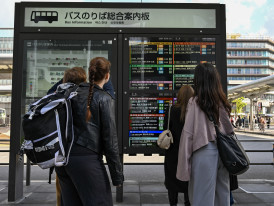
Tourists walking through Kyoto.
Building Flexibility into Your Schedule
While planning helps ensure you experience Kyoto's highlights, being flexible allows for the unexpected discoveries that often become the most treasured memories.
Weather conditions can significantly impact autumn viewing, making flexible scheduling essential. Having alternative indoor activities planned for rainy days prevents disappointment while still providing meaningful cultural experiences.
Peak color timing varies from year to year, making rigid scheduling counterproductive.
Building buffer time into your itinerary allows for extending stays at locations where the autumn display exceeds expectations while providing options for relocating if conditions disappoint.
Local recommendations often lead to experiences not found in guidebooks.
Maintaining openness to suggestions from hotel staff, shopkeepers, or fellow travelers can reveal tucked away locations that provide more personal autumn experiences.
The Deeper Meaning of Autumn in Kyoto
Beyond the visual spectacle and cultural activities, October in Kyoto offers opportunities for deeper reflection on themes that have shaped Japanese aesthetics and spiritual practice for over a millennium.
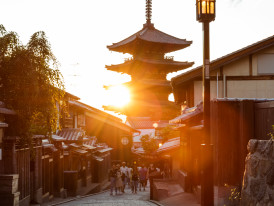
Hokanji Temple in Kyoto.
Impermanence and Beauty
The Buddhist concept of impermanence finds perfect expression in autumn's changing leaves.
This philosophical principle, deeply embedded in Japanese culture, provides a framework for understanding why autumn viewing carries such emotional resonance.
Watching leaves change color and fall provides concrete experience of impermanence that goes beyond intellectual understanding.
This direct encounter with transience creates opportunities for personal reflection that many visitors find unexpectedly meaningful.
The Japanese aesthetic principle of mono no aware, often translated as "the pathos of things," finds its most accessible expression in autumn leaf viewing.
This bittersweet awareness of beauty's temporary nature adds emotional depth to what might otherwise be simple sightseeing.
Connecting Past and Present
October in Kyoto demonstrates how traditional culture continues to evolve while maintaining its essential character.
This living heritage provides insights into how societies can preserve meaningful traditions while adapting to contemporary realities.
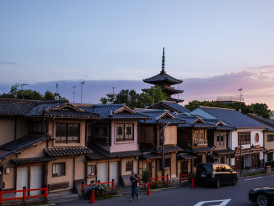
Kyoto street view.
Ancient temples serve contemporary spiritual needs while preserving architectural and artistic traditions that span centuries.
Visiting these active religious sites reveals how tradition functions as a living practice rather than museum display.
Festival celebrations demonstrate community continuity across generations, with elderly participants passing knowledge to younger community members who will carry these traditions forward.
Observing these intergenerational exchanges provides insights into cultural transmission processes.
Conclusion: The Lasting Gift of October in Kyoto
You stand in a temple garden as October light filters through red maple leaves.
Around you, the rustle of autumn and the faint sound of temple bells. In moments like this, visitors often feel something beyond ordinary sightseeing.
These encounters with seasonal beauty within spiritual settings provide experiences that resonate long after the return journey home.
There are more rewards to visiting Kyoto than checking famous temples off a travel list.
The true gifts come from allowing yourself to slow down, to observe carefully, and to remain open to the subtle lessons that centuries of seasonal awareness have embedded in this ancient city.
Maybe it’s the sight of a single red leaf drifting across a temple pond.
Or joining a local festival and feeling part of something old and meaningful. Or just a quiet moment in a garden built for reflection.
October in Kyoto leaves you with memories that stay long after you’ve gone.
For similar seasonal experiences in Japan, you might also explore things to do in Tokyo in September for late summer transitions, or discover more about our city through various Kyoto experiences available throughout the year.
The invitation is always open. Come back and see how each autumn writes its own story in the temple gardens and along the mountain paths.
October in Kyoto has something new to see every year. This can be another chapter in the quiet conversation between season and sacred space.
Explore Kyoto in October, Just Like a Local
SEE EXPERIENCESWhat if Kyoto in October Felt Like It Was Made for You?
City Unscripted pairs you with a local host to plan a private experience shaped around your interests, not a tour group’s itinerary.
Talk Directly to a Kyoto Local Before You Go
Get friendly, personalized advice from someone who knows the city and how to shape it around you.






